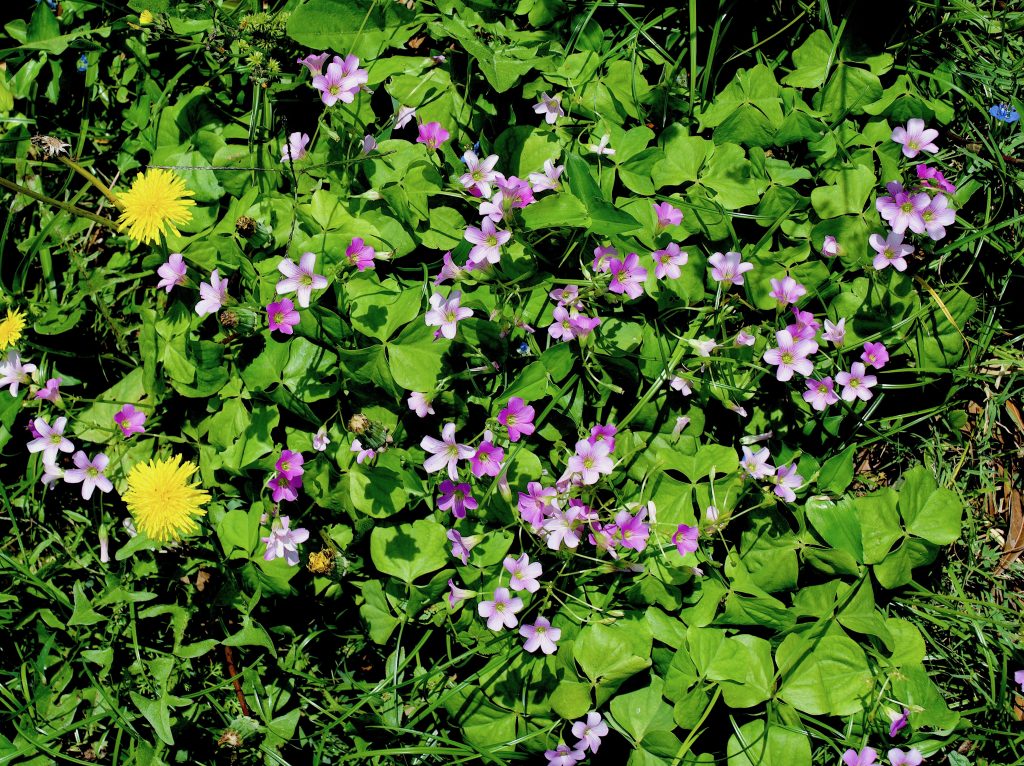
There are at least four edible species in this picture. Can you identify them? Photo by Green Deane
While the temperatures have been slightly on the cool side at night it’s been warm enough for plants in the day to know it’s spring and they are happy! In Gainesville this past week our foraging class saw two species of Blueberries blossoming and two species of pawpaws in flower. Also getting ready to blossom is the Toothache Tree. While the most prolific Morning Glory in area was up it’s still waiting for warmer days before flowering. We also saw three mushrooms jumping the season. They usually don’t start in earnest until after heavy rains in April or May.
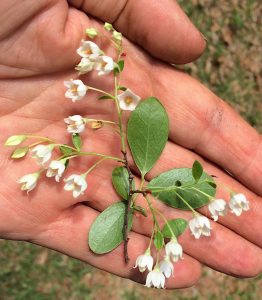
Sparkleberries are in blossom. Photo by Green Deane
April is a transition month. Many of winter edibles are ending their season and some of the spring and summer plants are starting. There is overlap and that can vary depending which end of the state you are on. The blueberries, also mentioned in last week’s newsletter, were impressive. I think they were Vaccinium arboreum, also called Sparkleberry and Farkleberry (and mistakenly Tree Huckleberry because they are not huckleberries.) We saw individual trees and a small hurst of them. V. arboreum is the only blueberry locally that gets to tree size. It has a flaking outer bark that reveals a reddish brown smooth inner bark. We also saw two Deerberry bushes, Vaccinium staminuem. That species is easy to identify because the blossoms have long stamens and the underside of the leaf is white. You can read about blueberries here. Incidentally, blueberries can have any number of seeds in them. Huckleberries, however, always have exactly 10 seeds. There can be bits of grit in a huckelberry but only 10 seeds. The leaves also have bright gold glands. You can read about Huckleberries here.
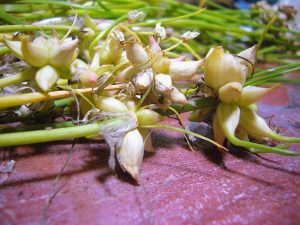
Wild Garlic puts the cloves on top. Photo by Green Deane
Also doing well now is Wild Garlic. You could also call it Wild Onion but its aroma is definitely garlic. I have found the Wild Garlic in numerous places in and about Gainesville. One of the most prolific sites is across the street from the official parking spot on Newnan’s Lake. And they are just down the street from fruiting Paper Mulberries. Our Wild Garlic is odd in that it puts an onion-like bulb on the bottom of the plant (usually three or four inches in the ground) and it puts cloves of garlic on the very top of the plant… and the part in between is edible as well. This garlic is seasonal and can be found for six weeks or so. You can read about it here. I used to conduct part of my class at the small park Newnan’s Lake but it is a haven for ticks. Speaking of which I got one last week and one this week. As tick season is not really here perhaps this year they will be worse than usual. Interestingly there is a study the suggest the allergy medication, Claritin, might be useful in fighting Lyme Disease.
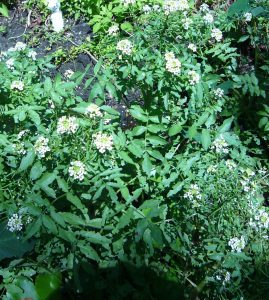
Watercress. Photo by Green Deane
As our cooler months is when we usually see wild members of the Brassica family most of them are nearing the end of their cycle as we warm up. Past season for the most part is Western Tansy Mustard. Wild Mustard and Wild Radish are nearing the end of their bloom and seed cycle. Poor Man’s Peppergrass is here all year but likes the cooler months. The one nice find this past week was Watercress. It’s an import from Europe but found throughout most of North America. Florida once was the winter Watercress growing capital of the United States. Consequently you can find it in nearly any drainage ditch that used to service agricultural land. You can also find in along the banks of local rivers. One thing you have to be very careful about when picking Watercress is not pick any deadly Water Hemlock leaves. They look different but both plants tend to grow in the same area at the same time. I have often seen them intermixed. So when I pick Watercress I examine every steam and leaf at least twice. To read more about Watercress go here.
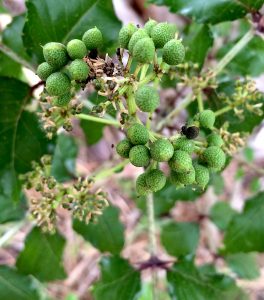
Shells of the berries can make a pepper substitute. Photo by Green Deane
A couple of hundred miles can make a botanical difference. In Melbourne, some 20 miles south of the space center, we saw a Toothache tree, Zanthoxylum clava-herculis, setting fruit. In Gainesville the same species was getting ready to blossom or had a few here and there. Also called Hercule’s Club, the thorns, bark and leaves have been used at least for centuries to numb aching teeth. It will also make you drool, a small inconvenience to silence an aching tooth. You can read about it here. Many Americans have actually eaten part of a relative of the Toothache Tree, Szechuan Pepper, Zanthoxylum simulans (and Z. bungeanum.) That spice is made from the seeds hulls of the species. We can use the seed hulls of our tree as well. The tree is covered with thorns so approach with care (And another thorny tree we saw this week was Aralia spinosa, which is not related but is sometimes also called Hercules Club.)
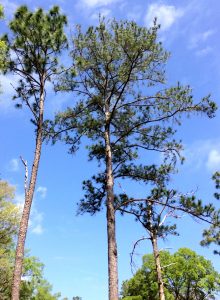
Long Left Pine left, Slash Pine right.
A few odds and ends from this week’s classes: We noticed Gopher Apples and Tallow Plums blossoming (interestingly green Tallow Plums were also used to numb toothaches.) Pawpaws were blossoming in both locations but with two different species in Gainesville. Also Sorrel in the Rumex genus is nearing the end of its seasons. That tart plant starts it seasonal run around November and usually fades in April. The leaves and seeds are edible and are related to Buckwheat. And by chance we also happened to see two species of pine that are often confused. As two were growing together it was worth a picture to help you sort them out. The Long Leaf Pine is on our left, and the Slash Pine is on our right.

Classes are held rain or shine or cold. Photo by Kelly Fagan
Foraging Classes: Perhaps because of the northern location but Gainesville has this past week probably the last sighting for Chickweed and Goosegrass for the season. While the Chickweed was still edible Goosegrass gets tough as it ages. But one can still roast the seeds.
Saturday April 7th, Colby-Alderman Park: 1099 Massachusetts Street, Cassadaga. Fla. 9 a.m., meet near the restrooms.
Sunday April 8th, Eagle Park Lake, 1800 Keene Road, Largo, FL 33771. 9 a.m. Meet at the pavilion near the dog park
Saturday, April 14th, Blanchard Park, 10501 Jay Blanchard Trail, Orlando, FL 32817. 9 a.m. Meet at the pavilion east of the tennis courts near the YMCA.
Sunday, April 15th, Red Bug Slough Preserve, 5200 Beneva Road, Sarasota, FL, 34233, 9 a.m.
Saturday, April 22nd, Spruce Creek, 6250 Ridgewood Ave. Port Orange, 32127, 9 a.m., meet at the pavilion.
Saturday, May 5th, Florida State College, south campus, 11901 Beach Blvd., Jacksonville, 32246. 9 a.m. We will meet at building “D” next to the administration parking lot.
To read more about the classes or to pre-pay go here.

Green Deane DVD Set
All of Green Deane’s videos available for free on You Tube. They do have ads on them so every time you watch a Green Deane video I get a quarter of one cent. Four views, one cent. Not exactly a large money-maker but it helps pays for this newsletter. If you want to see the videos without ads and some in slightly better quality you can order the DVD set. It is nine DVDs with 15 videos on each for a total of 135 videos. Many people want their own copy of the videos or they have a slow service and its easier to order then to watch them on-line. The DVDs make a good gift for that forager you know especially on long, cold winter months. Individual DVDs can also be ordered or you can pick and choose. You can order them by clicking on the button on the top right hand side of this page (if your window is open wide enough.) Or you can go here

Green Deane Forum
Want to identify a plant? Looking for a foraging reference? Do you have a UFO, an Unidentified Flowering Object you want identified? On the Green Deane Forum we chat about foraging all year. And it’s not just about warm-weather plants or just North American flora. Many nations around the world share common weeds so there’s a lot to talk about. There’s also more than weeds. The reference section has information for foraging around the world. There are also articles on food preservation, and forgotten skills from making bows to fermenting food. One special section is “From the Frightening Mail Bag” where we learn from people who eat first then ask questions later. Recent topics include: Lyme Disease and Manganese, Vacciniums 2018, When to Harvest Betony Tubers, What Tree/Plant is this?, My Claytonia, Thistle Flower Buds, Pond Question, Compass Question, and Common Sweetleaf. You can join the forum by clicking on “forum” in the menu.
 Donations to upgrade EatTheWeeds.com and fund a book are going well and has made the half way mark. Thank you to all who have contributed to either via the Go Fund Me link, the PayPal donation link or by writing to Green Deane POB 941793 Maitland FL, 32794. Recent upgrades have been paid now the Forum needs work and several function problems need to be fixed specifically the search and categories ( a partial solution is that when you do a search other finds are directly below the main one shown. Scroll down.) A new server also has to be found by April 9th. The other issue is finding an indexing program or function for a real book. Writing programs used to do it automatically if you designated a term for indexing. Now that most books are ebooks most writing programs do not provide and indexing function. The hunt continues.
Donations to upgrade EatTheWeeds.com and fund a book are going well and has made the half way mark. Thank you to all who have contributed to either via the Go Fund Me link, the PayPal donation link or by writing to Green Deane POB 941793 Maitland FL, 32794. Recent upgrades have been paid now the Forum needs work and several function problems need to be fixed specifically the search and categories ( a partial solution is that when you do a search other finds are directly below the main one shown. Scroll down.) A new server also has to be found by April 9th. The other issue is finding an indexing program or function for a real book. Writing programs used to do it automatically if you designated a term for indexing. Now that most books are ebooks most writing programs do not provide and indexing function. The hunt continues.
This is weekly issue 298. (By the way, for any locals: At the intersection of Dirksen Drive and 17-92 in South Volusia County, the north end of the field in the southeast corner of that intersection is heavy in Pawpaw blossoms now. In total there’s about 100 Pawpaws there in bloom… and later bearing fruit.)
If you would like to donate to Eat The Weeds please click here.


It’s lovely to see the blossoms of the prolific Morning glory . In my case, I’m enjoying the prolifc ” Sabah elkhair ” – vernacular for Potulaca grandifolia and meaning ” Good morning ” – nowadays blossoming vividly with lovely red scarlet red petals . We use the plant as an easy to nurse ornamental .